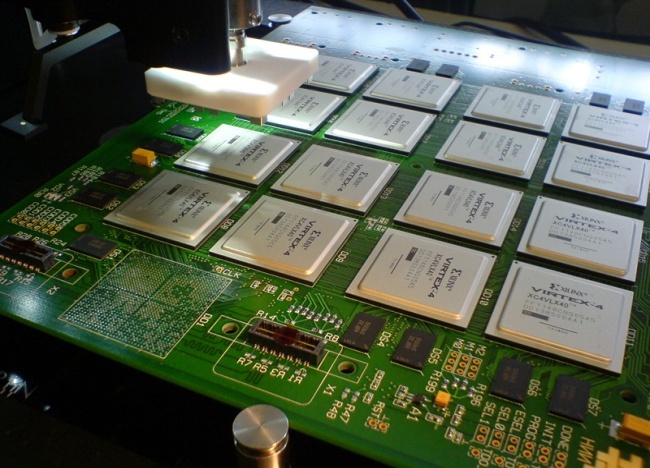|
Interposer
An interposer is an electrical interface routing between one socket or connection and another. The purpose of an interposer is to spread a connection to a wider pitch or to reroute a connection to a different connection. An interposer can be made of either silicon or organic (printed circuit board-like) material. Interposer comes from the Latin word , meaning "to put between".interposes - definition of interposes by the Free Online Dictionary, Thesaurus and Encyclopedia They are often used in [...More Info...] [...Related Items...] OR: [Wikipedia] [Google] [Baidu] |
Three-dimensional Integrated Circuit
A three-dimensional integrated circuit (3D IC) is a MOSFET, MOS (metal-oxide semiconductor) integrated circuit (IC) manufactured by stacking as many as 16 or more ICs and interconnecting them vertically using, for instance, through-silicon vias (TSVs) or Cu-Cu connections, so that they behave as a single device to achieve performance improvements at reduced power and smaller footprint than conventional two dimensional processes. The 3D IC is one of several 3D integration schemes that exploit the z-direction to achieve electrical performance benefits in microelectronics and nanoelectronics. 3D integrated circuits can be classified by their level of interconnect hierarchy at the global (Integrated circuit packaging, package), intermediate (bond pad) and local (transistor) level. In general, 3D integration is a broad term that includes such technologies as 3D wafer-level packaging (3DWLP); 2.5D and 3D interposer-based integration; 3D stacked ICs (3D-SICs); 3D heterogeneous integr ... [...More Info...] [...Related Items...] OR: [Wikipedia] [Google] [Baidu] |
High Bandwidth Memory
High Bandwidth Memory (HBM) is a computer memory interface for 3D-stacked synchronous dynamic random-access memory (SDRAM) initially from Samsung, AMD and SK Hynix. It is used in conjunction with high-performance graphics accelerators, network devices, high-performance datacenter AI ASICs, as on-package cache in CPUs and on-package RAM in upcoming CPUs, and FPGAs and in some supercomputers (such as the NEC SX-Aurora TSUBASA and Fujitsu A64FX). The first HBM memory chip was produced by SK Hynix in 2013, and the first devices to use HBM were the AMD Fiji GPUs in 2015. HBM was adopted by JEDEC as an industry standard in October 2013.High Bandwidth Memory (HBM) DRAM (JESD235) JEDEC, October 2013 The second generation, HBM2, was accepted by JEDEC in January 2016. [...More Info...] [...Related Items...] OR: [Wikipedia] [Google] [Baidu] |
Multi-chip Module
A multi-chip module (MCM) is generically an electronic assembly (such as a package with a number of conductor terminals or Lead (electronics), "pins") where multiple integrated circuits (ICs or "chips"), semiconductor Die (integrated circuit), dies and/or other discrete components are integrated, usually onto a unifying substrate, so that in use it can be treated as if it were a larger IC. Other terms for MCM packaging include "heterogeneous integration" or "hybrid integrated circuit". The advantage of using MCM packaging is it allows a manufacturer to use multiple components for modularity and/or to improve yields over a conventional monolithic IC approach. A Flip Chip Multi-Chip Module (FCMCM) is a multi-chip module that uses flip chip technology. A FCMCM may have one large die and several smaller dies all on the same module. Overview Multi-chip modules come in a variety of forms depending on the complexity and development philosophies of their designers. These can range from ... [...More Info...] [...Related Items...] OR: [Wikipedia] [Google] [Baidu] |
Virtex 7
Virtex is the flagship family of Field-programmable gate array, FPGA products currently developed by AMD, originally Xilinx before being acquired by the former. Other current product lines include Kintex (mid-range) and Artix (low-cost), each including configurations and models optimized for different applications.DSP-FPGA.comXilinx FPGA Products” April 2010. Retrieved June 10, 2010. In addition, AMD offers the Spartan low-cost series, which continues to be updated and is nearing production utilizing the same underlying architecture and process node as the larger 7-series devices. Virtex FPGAs are typically programmed in hardware description languages such as VHDL or Verilog, using the Xilinx ISE or Vivado computer software.Brian Bailey, EE Times.Second generation for FPGA software" Apr 25, 2012. Retrieved Dec 21, 2012. Xilinx FPGA products have been recognized by EE Times, EDN and others for innovation and market impact.EE Times, �EE Times 2010 ACE Award for Design Innovation.� ... [...More Info...] [...Related Items...] OR: [Wikipedia] [Google] [Baidu] |
Ball Grid Array
A ball grid array (BGA) is a type of surface-mount packaging (a chip carrier) used for integrated circuits. BGA packages are used to permanently mount devices such as microprocessors. A BGA can provide more interconnection pins than can be put on a dual in-line or flat package. The whole bottom surface of the device can be used, instead of just the perimeter. The traces connecting the package's leads to the wires or balls which connect the die to package are also on average shorter than with a perimeter-only type, leading to better performance at high speeds. Soldering of BGA devices requires precise control and is usually done by automated processes such as in computer-controlled automatic reflow ovens. Description The BGA is descended from the pin grid array (PGA), which is a package with one face covered (or partly covered) with pins in a grid pattern which, in operation, conduct electrical signals between the integrated circuit and the printed circuit board (PCB) ... [...More Info...] [...Related Items...] OR: [Wikipedia] [Google] [Baidu] |
AMD Radeon RX 300 Series
The Radeon 300 series is a series of graphics processors developed by AMD. All of the GPUs of the series are produced in 28 nm format and use the Graphics Core Next (GCN) micro-architecture. The series includes the Fiji and Tonga GPU dies based on AMD's GCN 3 or "Volcanic Islands" architecture, which had originally been introduced with the Tonga based (though cut-down) R9 285 slightly earlier. Some of the cards in the series include the Fiji based flagship AMD Radeon R9 Fury X, cut-down Radeon R9 Fury and small form factor Radeon R9 Nano, which are the first GPUs to feature High Bandwidth Memory (HBM) technology, which AMD co-developed in partnership with SK Hynix. HBM is faster and more power efficient than GDDR5 memory, though also more expensive. However, the remaining GPUs in the series outside the Tonga based R9 380 and R9 380X are based on previous generation GPUs with revised power management, and therefore only feature GDDR5 memory (something Tonga does as well). ... [...More Info...] [...Related Items...] OR: [Wikipedia] [Google] [Baidu] |
Serial Attached SCSI
In computing, Serial Attached SCSI (SAS) is a point-to-point serial Communications protocol, protocol that moves data to and from Computer storage, computer-storage devices such as hard disk drives, solid-state drives and tape drives. SAS replaces the older Parallel SCSI (Parallel Small Computer System Interface, usually pronounced "scuzzy" ) bus technology that first appeared in the mid-1980s. SAS, like its predecessor, uses the standard SCSI command, SCSI command set. SAS offers optional compatibility with Serial ATA (SATA), versions 2 and later. This allows the connection of SATA drives to most SAS backplanes or controllers. The reverse, connecting SAS drives to SATA backplanes, is not possible. The T10 technical committee of the International Committee for Information Technology Standards (INCITS) develops and maintains the SAS protocol; the SCSI Trade Association (SCSITA) promotes the technology. Introduction A typical Serial Attached SCSI system consists of the following ... [...More Info...] [...Related Items...] OR: [Wikipedia] [Google] [Baidu] |
CMOS
Complementary metal–oxide–semiconductor (CMOS, pronounced "sea-moss ", , ) is a type of MOSFET, metal–oxide–semiconductor field-effect transistor (MOSFET) semiconductor device fabrication, fabrication process that uses complementary and symmetrical pairs of p-type semiconductor, p-type and n-type semiconductor, n-type MOSFETs for logic functions. CMOS technology is used for constructing integrated circuit (IC) chips, including microprocessors, microcontrollers, memory chips (including Nonvolatile BIOS memory, CMOS BIOS), and other digital logic circuits. CMOS technology is also used for analog circuits such as image sensors (CMOS sensors), data conversion, data converters, RF circuits (RF CMOS), and highly integrated transceivers for many types of communication. In 1948, Bardeen and Brattain patented an insulated-gate transistor (IGFET) with an inversion layer. Bardeen's concept forms the basis of CMOS technology today. The CMOS process was presented by Fairchild Semico ... [...More Info...] [...Related Items...] OR: [Wikipedia] [Google] [Baidu] |
Integrated Circuit
An integrated circuit (IC), also known as a microchip or simply chip, is a set of electronic circuits, consisting of various electronic components (such as transistors, resistors, and capacitors) and their interconnections. These components are etched onto a small, flat piece ("chip") of semiconductor material, usually silicon. Integrated circuits are used in a wide range of electronic devices, including computers, smartphones, and televisions, to perform various functions such as processing and storing information. They have greatly impacted the field of electronics by enabling device miniaturization and enhanced functionality. Integrated circuits are orders of magnitude smaller, faster, and less expensive than those constructed of discrete components, allowing a large transistor count. The IC's mass production capability, reliability, and building-block approach to integrated circuit design have ensured the rapid adoption of standardized ICs in place of designs using discre ... [...More Info...] [...Related Items...] OR: [Wikipedia] [Google] [Baidu] |
Die Preparation
Die preparation is a step of semiconductor device fabrication during which a wafer is prepared for IC packaging and IC testing. The process of die preparation typically consists of two steps: wafer mounting and wafer dicing. Wafer mounting Wafer mounting is a step that is performed during the die preparation of a wafer as part of the process of semiconductor fabrication. During this step, the wafer is mounted on a plastic tape that is attached to a ring. Wafer mounting is performed right before the wafer is cut into separate dies. The adhesive film upon which the wafer is mounted ensures that the individual dies remain firmly in place during 'dicing', as the process of cutting the wafer is called. The picture on the right shows a 300 mm wafer after it was mounted and diced. The blue plastic is the adhesive tape. The wafer is the round disc in the middle. In this case, a large number of dies were already removed. Semiconductor-die cutting In the manufacturing of micro ... [...More Info...] [...Related Items...] OR: [Wikipedia] [Google] [Baidu] |
Storage Networking Industry Association
The Storage Networking Industry Association (SNIA) is an American trade association, incorporated in December 1997. It is a registered 501(c)(6) non-profit organization. SNIA has more than 185 unique members, 2,000 active contributing members, and over 50,000 IT end users and storage professionals. Description SNIA's membership community participates in the following storage-related technical working groups: * Cloud Storage Technologies * Computational Storage * Data Management * Data Security * Dictionary * DNA Data Storage * Networked Storage * Next Generation Data Center * Persistent Memory * Physical Storage * Power Efficiency Measurement * Storage Management Initiative – Specification (SMI-S) * SNIA Swordfish® - Scalable Storage Management Specificati SNIA and its technical council maintain a vendor-neutral dictionary and glossary of storage networking, data, and information management terminology. The SNIA dictionary won an award for publication excellence in 2009 and ... [...More Info...] [...Related Items...] OR: [Wikipedia] [Google] [Baidu] |
Redundancy (engineering)
In engineering and systems theory, redundancy is the intentional duplication of critical components or functions of a system with the goal of increasing reliability of the system, usually in the form of a backup or fail-safe, or to improve actual system performance, such as in the case of GNSS receivers, or multi-threaded computer processing. In many safety-critical systems, such as fly-by-wire and hydraulic systems in aircraft, some parts of the control system may be triplicated, which is formally termed triple modular redundancy (TMR). An error in one component may then be out-voted by the other two. In a triply redundant system, the system has three sub components, all three of which must fail before the system fails. Since each one rarely fails, and the sub components are designed to preclude common failure modes (which can then be modelled as independent failure), the probability of all three failing is calculated to be extraordinarily small; it is often outweighed ... [...More Info...] [...Related Items...] OR: [Wikipedia] [Google] [Baidu] |


